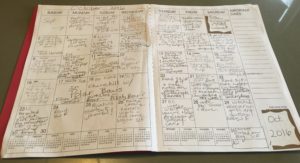After assigning a page of math homework to my first graders, one of my students said, “I might not be able to do this tonight.” When I asked her why, she said she had soccer practice and play rehearsal after school. I told her it sounded like she had too much going on in her life. She smiled and said, “Oh no, I love being busy.” I smiled back. I totally understood. I love being busy, too.
As a teacher, I usually operated on high-speed. My classroom was a bustling whirlwind of dynamic lessons and activities. We always got a lot done. And I had my plan book and assessments to prove it. At home, my family kept track of our plethora of commitments on a large, color-coded calendar. I also made personal to-do lists on yellow legal pads, scribbled reminders to myself on post-it notes, and rolled into bed each night, ready to do it again in the morning. It was a fast, over-scheduled pace, but I reveled in it.
Today, I have a new life. I’m a full-time writer. My children have flown the coop, and except for hanging out with my retired husband, my time is my own. I can slow it down, write for hours on end, read books on craft, drink lots of pumpkin lattes. My only problem is that the over-scheduling person inside me is still there. She constantly nags me to get more done, check things off my list (I still make them), get published already. Hop, jump, repeat! Man is she annoying. But I can’t get rid of her. She is a big part of who I am. I just have to figure out how to deal with her.
At first, I tried integrating techniques that worked for me as a teacher, into my life as a writer. I made schedules, set goals, took classes, read books, attended conferences, workshops, and writing groups. I still do these things. But something was missing. I didn’t feel like I was accomplishing enough. Especially when I veered from my “plan” or failed to achieve my goals.
One morning, as I sipped a homemade latte and stared at my computer screen, a radical idea popped into my head. Instead of planning out my week of writing, I would reflect on it. I would do something EVERY SINGLE DAY (even for a short amount of time) to further my life as a writer and record these activities in a daily log. Not a plan-book, a logbook. I immediately went out and bought a calendar/notebook with large 1½ inch squares and decided to get started. (You can also use the new RMC-SCBWI calendar if you order your copy ASAP!) And here’s the key: I only record writing activities in it. No dentist appointments or lunch dates allowed.
I’ve been logging for a month now and I’m pretty excited about how it’s going. At the end of each day, I jot down anything I’ve done that relates to writing for children. I’ve included: worked on my novel, did a character exercise, talked with a picture book collaborator, listened to a webinar class on revision, read a book in my genre, went to hear an author speak at Tattered Cover, sent emails to SCBWI volunteers for an upcoming conference, attended a critique group meeting, made notes for my works-in-progress, wrote this blogpost, and did research at a museum. It’s amazing. I can now see, in black and white, that I am living a writer’s life. Every single day. Well, almost.
Becoming a great writer takes time. And there is more to the journey than the actual writing component. But now, when I look at my writing log, I see that I’m really trying. I’m doing all kinds of things to move this new life forward. And when that ever-present “busy teacher” is nudging me to get things done, I open my logbook and say, “I am. I totally am.”
Author’s note: If you try using a writing log, let me know how it goes!

